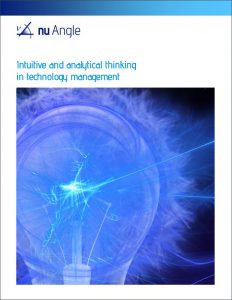 People in R&D usually have a mix of science, technology, engineering, and mathematics training and this requires structured analytical thinking. But interestingly many of these people are easily led astray by their intuitions, especially when working on problems outside their ‘discipline’, such as technology management. Dr Steve Bone’s White Paper explores why this might be and offers techniques and tools for overcoming the kinds of cognitive biases prompted by extremes of thinking.
People in R&D usually have a mix of science, technology, engineering, and mathematics training and this requires structured analytical thinking. But interestingly many of these people are easily led astray by their intuitions, especially when working on problems outside their ‘discipline’, such as technology management. Dr Steve Bone’s White Paper explores why this might be and offers techniques and tools for overcoming the kinds of cognitive biases prompted by extremes of thinking.
Successful technology and R&D management lies in the objective, skilful and strategic allocation of resources to bring about growth through the right technologies. But while facilitating a technology strategy process for a global cosmetics company, I became acutely aware that extreme thinking styles – be those intuitive or analytical – could significantly disrupt the process. When objectivity is threatened either by members of the team becoming too driven by ‘gut feeling’ or too focused on specific and sometimes irrelevant evidence that slows process, the outcome of a project can be catastrophic.
Gut feelings can be positive and fast, but short-sighted and biased
We are all to some extent intuitive thinkers. Our emotions guide us in solving problems and making key decisions in our lives – evolution has honed this instinct to help us quickly and effortlessly achieve ‘good enough’ outcomes that ensure ‘survival.’ However intuitive thinking alone can create ‘conformational bias’ (picking information that fits your world view) and within R&D, this can send you down the wrong technology track or miss possibilities that fall outside your own experience.
In some disciplines – medicine, for example – intuitive decision-making comes into its own, particularly when the person has a large amount of experience in precisely the type of problem needing to be solved ‘quickly’. But for R&D management this can be disastrous because R&D outputs are long term and the true impact of acting on gut instinct might not reveal itself for years – by which time it’s too late to change direction.
Evidence can be reassuring, but may lead to ‘Analysis Paralysis’
As the VP of Global Product and Applications Development for a world leading supplier of speciality chemicals and ingredients observed to me: “emerging technologies can be seen as a threat, so it is not uncommon for experts to try and stay in their comfort zone, using older technologies rather than learn something new.” This can result in analytical people getting ‘analysis paralysis’, preventing them thinking outside the box.
Personality types can further impact the dynamic of a team, and consequently, can jeopardise successful technology strategy creation. People dynamics are a crucial factor in the success of a project – the strongest voices bias the group more, especially if they are held in high regard – and may impact the outcome.
Successful Technology Management blends two modes of thinking
It’s important not to think of intuitive and analytical thinkers as two different types of people.
The word ‘technology’ comes from the Greek techne (meaning art) and logos (logic or science) and so technology management can naturally exploit both analytical (inductive methods, tools and techniques) and intuitive (creativity, experience, lateral thinking) processes.
Analytical thinking is focused, linear, objective, removes bias, and deals with one thing at a time.
Intuitive thinking provides the ‘big picture’, therefore it’s very important for strategy development.
 Since all of us are capable of both modes of reasoning. Offering opportunities for blended modes of thinking within a technology management project opens up the scope for a more positive result, as success is linked to a genuine mix of creativity, objectivity and analysis.
Since all of us are capable of both modes of reasoning. Offering opportunities for blended modes of thinking within a technology management project opens up the scope for a more positive result, as success is linked to a genuine mix of creativity, objectivity and analysis.
Solutions
- When putting together a team for a technology management project, different thinking styles should be facilitated as far as possible. Once the team is in place, good project management is essential, bearing in mind that the more preparation you do, the smoother meetings and workshops will be – and the better the outcomes as a result.
- External facilitators with no vested interest in the outcome of a project can assist this process, but should have many years of experience of technology management in several types of companies in different industry sectors.
- An objective group of external technology, business and market experts can add new insights and challenge the work, while software can be deployed to help rank technologies against business and technology criteria such as strategic fit, market attractiveness, cost, risk, maturity etc.
Read more
Read the nu Angle White Paper “Intuitive and Analytical Thinking in Technology Management” here to see specific tools and guidelines for project facilitation.
White paper by Steve Bone, post by R&D Today admin.

